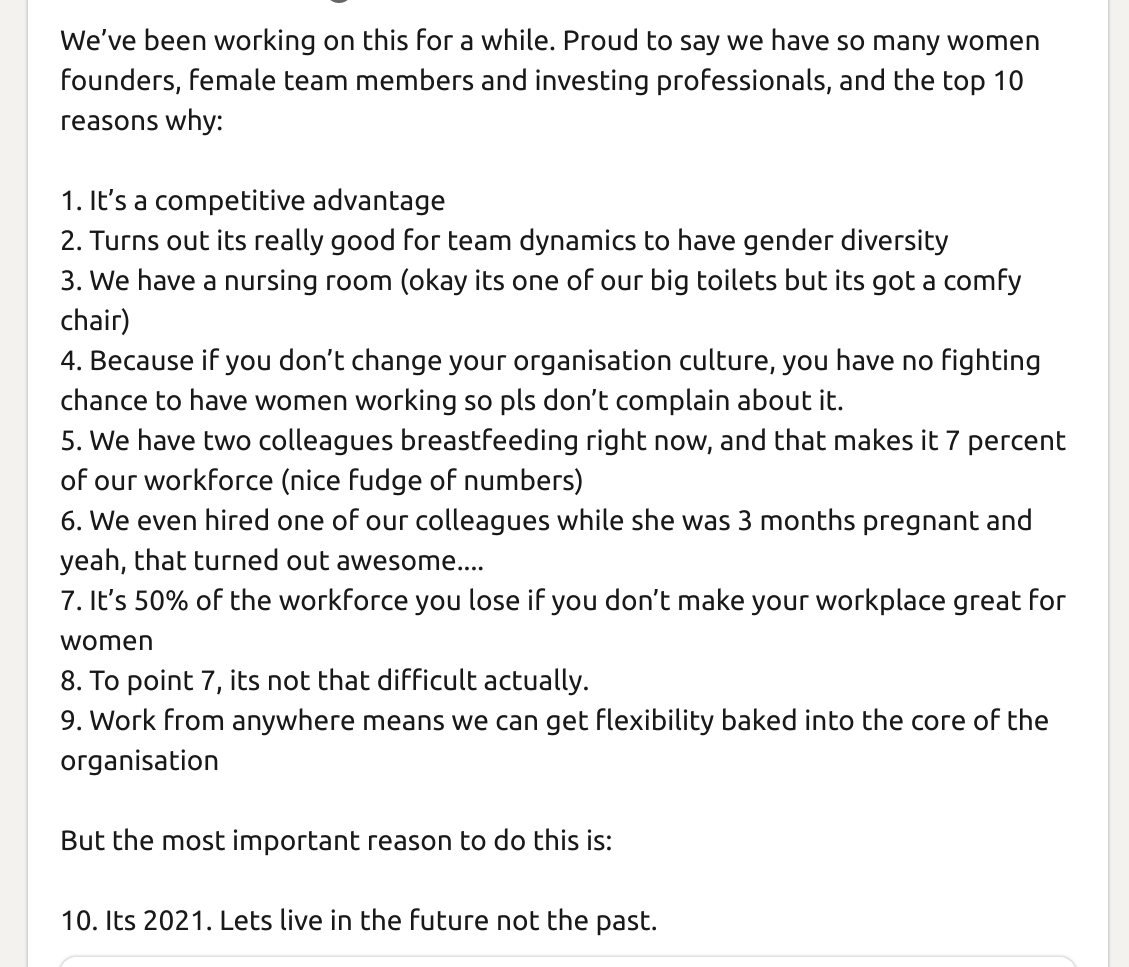“Institutional sexism” is an abstract concept for many of us. It’s often difficult to put into words.
This post appeared on my LinkedIn feed on 8th of March this year. The poster is a partner at a VC.

It’s an excellent example of institutional sexism.
First of all, institutional sexism is posting about gender diversity only on 8th of March because it’s acutely aware of the marketing potential. I went through the poster’s and the company’s history and the website and there were no other mentions of it before or since.
“1. It’s a competitive advantage”
Institutional sexism is vague. It often doesn’t directly discriminate but does constantly undermine in vague terms.
It has heard that gender diversity is a competitive advantage but is neither totally convinced nor sure what that means.
“2. Turns out its really good for team dynamics to have gender diversity”
Institutional sexism thinks that the benefits of diverse teams have only recently been discovered. It also thinks that any sort of benefits derived from inclusiveness and diversity are shocking to everyone else as much as they are to it.
“3. We have a nursing room (okay its one of our big toilets but its got a comfy chair)”
Institutional sexism constantly equates women with babies.
It also often does only the bare minimum to actually promote inclusiveness. The term “virtue signalling” is apt here.
I also seriously doubt the benefit of bragging about having a nursing room that’s actually a chair in a toilet.
“4. Because if you don’t change your organization culture, you have no fighting chance to have women working so pls don’t complain about it.”
Institutional sexism recognizes that times are changing but it’s just something that must be done, even if you hate it. Like eating your veg.
Broadly, it’s either resisting the change (“complaining about it”) or is at best passive about it and only doing the bare minimum to qualify. Such as putting chairs in toilets and calling them nursing rooms.
“5. We have two colleagues breastfeeding right now, and that makes it 7 percent of our workforce (nice fudge of numbers)”
Once again, institutional sexism equates women with babies.
I also question the authors need to (a) know and (b) publicly post about the breastfeeding habits of his team.
“6. We even hired one of our colleagues while she was 3 months pregnant and yeah, that turned out awesome….”
Just in case it was not clear, WOMEN == BABIES.
The author also seems to disregard that it’s unlawful to discriminate based on pregnancy. But legality is not really a problem for institutional sexism.
I also question what seems to be a sarcastic tone of how hiring someone who was pregnant worked out.
“7. It’s 50% of the workforce you lose if you don’t make your workplace great for women”
Institutional sexism seems to have realized this finally. Women are approximately 50% of the workforce. Good work.
“8. To point 7, its not that difficult actually.”
Institutional sexism is shocked that not alienating people is “not that difficult actually”.
It also needs to brag about doing the bare minimum.
“9. Work from anywhere means we can get flexibility baked into the core of the organization”
Institutional sexism is aware that people want more flexibility but women particularly because they have to do all the baby-related things.
“10. Its 2021. Lets live in the future not the past.”
Institutional sexism does see the change coming but it requires constant praise whenever it makes even the slightest of improvements.
That’s what it looks like
It’s sometimes difficult to recognize because it’s hidden in a veil of virtue signalling. It’s about companies posting about gender equality once a year and completely disregarding it the rest of the year.
Do note the lack of any points about:
- Ability
- Sexual harassment policies
- Recruitment policies
- Childcare in general other than breastfeeding
- Legality
- Paternal leave
So, what’s to be done?
Promoting inclusiveness requires a genuine desire not only to include others but to make others feel less excluded. It’s about making sure people don’t leave as much as it is making sure people want to join. It’s not about having a nursing room, it’s about not keeping track of who’s nursing.
At times, well thought out indirect support is better than insincere direct support. It’s not just about making sure your organization doesn’t tolerate harassment, it’s about making sure your clients don’t either.
It also extends beyond policies that affect only your people. For instance, having generous paternal leave also promotes inclusiveness. One person taking paternal leave means another, who might not be a part of your organization, will feel more included.
In these ways, sexism embedded in the institution can be affected.
But hey, at least they’re doing something 🤷
